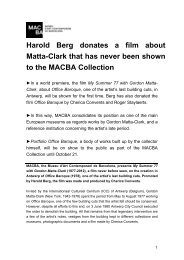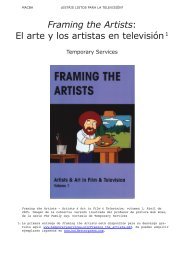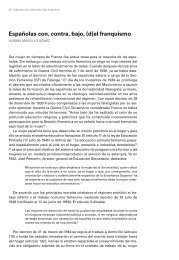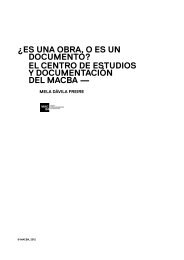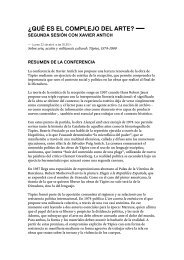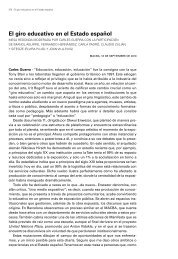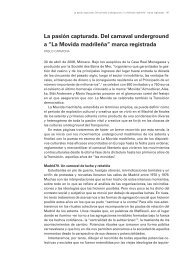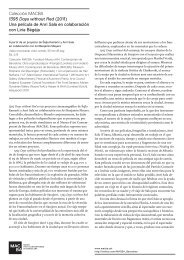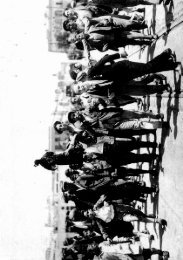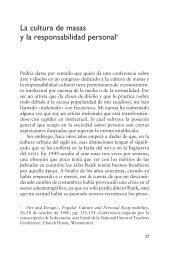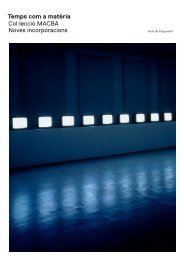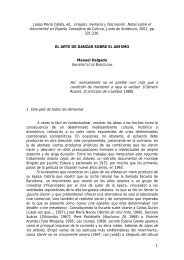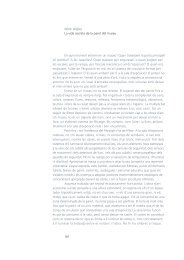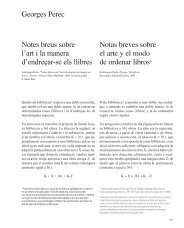Chance, Indeterminacy, Multiplicity - Macba
Chance, Indeterminacy, Multiplicity - Macba
Chance, Indeterminacy, Multiplicity - Macba
You also want an ePaper? Increase the reach of your titles
YUMPU automatically turns print PDFs into web optimized ePapers that Google loves.
33. In Music for Carillon I, Cage used a<br />
stencil made from crumpled paper<br />
to determine the placement of the dots.<br />
In scores using transparencies, he<br />
used randomly arrayed dots printed<br />
on paper or moveable transparencies.<br />
34. Cage, “45’ for a Speaker,” p. 157.<br />
On the point-drawing technique,<br />
see Pritchett, pp. 92ff.<br />
35. John Cage, “Experimental Music”<br />
(1957), Silence, p. 9.<br />
36. The term “field situation” appears<br />
in John Cage, “Diary: How to Improve<br />
the World (You Will Only Make Matters<br />
Worse) 1967,” A Year from Monday.<br />
Middletown, Conn.: Wesleyan University<br />
Press, 1967, p. 157.<br />
37. Cage, “Experimental Music,” p. 9.<br />
38. Gilles Deleuze and Félix Guattari,<br />
A Thousand Plateaus: Capitalism and<br />
Schizophrenia, Brian Massumi, (trans.),<br />
Minneapolis: University of Minnesota<br />
Press, 1987, p. 371.<br />
immediately notated dots on a sheet of paper by, for instance,<br />
marking a number of imperfections found on the sheet within a<br />
given amount of time. 33 These points could then be translated into<br />
sounds by establishing different means of mapping by which their<br />
frequency, amplitude, timbre, duration, and “morphology” (attack<br />
and decay characteristics) could be determined independently<br />
of the composer’s preconceptions. No longer beginning in the mind<br />
of the composer, the composition now drew its materials from the<br />
entirety of an acoustical “field.” “The reason I am presently working<br />
with imperfections in paper is this,” Cage noted in 1954. “I am<br />
thus able to designate certain aspects of sound as though they were<br />
in a field, which of course they are.” 34<br />
Cage’s conception of sound as existing within a field was precipitated<br />
by his interest in technology. In Cage’s estimation, the capabilities<br />
of, for instance, magnetic tape allowed for the possibility<br />
not only of reproducing any sound but, through various means of<br />
manipulation, producing every possible sound. Sound thereby<br />
became conceivable as a continuous expanse without gap, division,<br />
or lacuna. As Cage explained in “Experimental Music”:<br />
Musical habits include scales, modes, theories of counterpoint and harmony,<br />
and the study of the timbres, singly and in combination of a limited number of<br />
sound-producing mechanisms. In mathematical terms these all concern discrete<br />
steps. They resemble walking – in the case of pitches, on steppingstones twelve in<br />
number. This cautious stepping is not characteristic of the possibilities of magnetic<br />
tape, which is revealing to us that musical action or existence can occur at any<br />
point or along any line or curve or what have you in total sound-space; that we are,<br />
in fact, technically equipped to transform our contemporary awareness of nature’s<br />
manner of operation into art. 35<br />
Although continuous and unlimited, the “total sound-space”<br />
implied in Cage’s “field situation” was, importantly, not homogeneous.<br />
36 Any movement or transformation in coordinates equaled<br />
a transformation in acoustic identity. Once again describing the<br />
effects of magnetic tape, Cage stated:<br />
The situation made available by these means is essentially a total soundspace,<br />
the limits of which are ear-determined only, the position of a particular<br />
sound in this space being the result of five determinants: frequency or pitch,<br />
amplitude or loudness, overtone structure or timbre, duration, and morphology<br />
(how the sound begins, goes on, and dies away). By the alteration of any one of<br />
these determinants, the position of the sound in sound-space changes. 37<br />
Continuous, but also heterogeneous, Cage’s total sound-space is<br />
what Gilles Deleuze and Félix Guattari would call a “smooth space”;<br />
all points are reachable, but none are identical. 38 “I believe, of<br />
219



